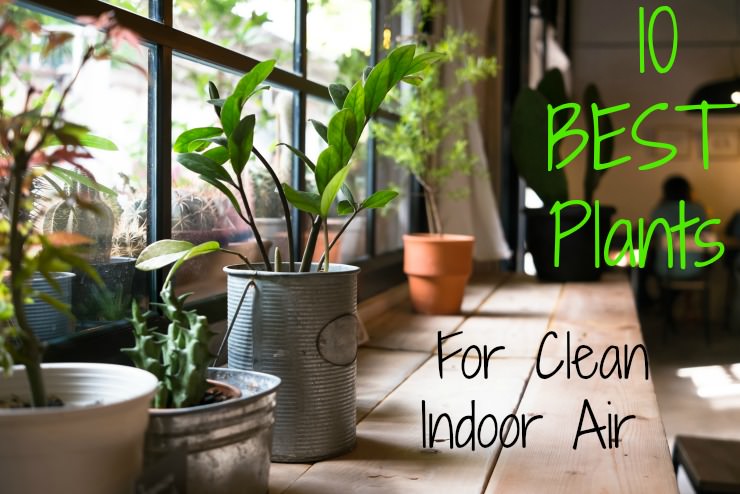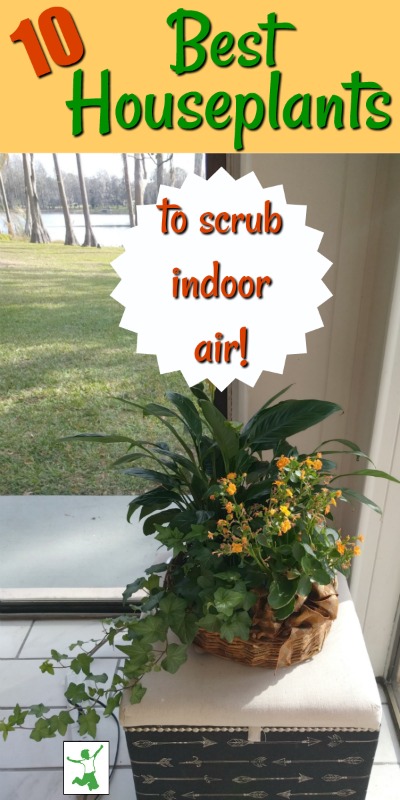The top ten house plants that effectively clean toxins from indoor air as demonstrated by a NASA study. Plants are much cheaper and easier to maintain than air filters too!
Research by NASA on the air-filtering effect of house plants concluded as early as 1989 that they are a powerful means to remedy indoor air pollution.
The first list of the best house plants for this purpose was compiled as part of the NASA Clean Air Study. It researched simple, sustainable ways to clean air on space stations. Under NASA’s controlled conditions, certain house plants were found to remove as much as 87 percent of indoor air pollutants within 24 hours.
The air cleaning capability of plants maintained within a closed living environment goes far and beyond simple removal of carbon dioxide (which humans and animals exhale) and replacing it with clean oxygen.
House plants also have the remarkable ability to remove toxins such as benzene, formaldehyde, and trichloroethylene from the air. These chemicals can be a particular health hazard for those living or working in newly built residential homes, apartments, and commercial office space.
It wasn’t until the 1980s when indoor air pollution suddenly became a health issue that needed to be addressed. The energy shortages of the 1970s triggered the crisis as more people began to insulate their homes and office buildings. The reason? To conserve energy and lower heating and cooling costs. New construction was built to be especially energy-efficient. Prior to that, buildings leaked so much air that sufficient circulation occurred even with doors and windows closed.
“Sick building syndrome” is the term used to describe the symptoms of those suffering the negative health effects of toxic indoor air from breathing outgassed chemicals. It also describes the illness suffered by those living in buildings contaminated by mold. Unfortunately, house plants cannot counteract this contaminant.
In addition to outgassed chemicals from the construction process, commonly used household consumer products play a role in poor air quality. They can contribute to indoor air pollution with carcinogenic xylene, toluene, and ammonia. Primary sources are aerosols and spray cans.
Replacement of these toxic consumer products with green alternatives is the best solution. Sometimes, however, this goal is not possible in a family or roommate situation. Occasionally, people living under the same roof do not share the same environmental worldview. In that situation, the beneficial air-filtering effects of house plants are most desperately needed. This is especially true given that most of us spend 80-90% of our time indoors!
How Many House Plants Necessary to Clean the Air?
NASA researchers suggest that the optimal air-filtering effect is achieved with at least one potted plant per 100 square feet of home or office space (1). One large plant or several smaller ones can be used for a spacious area such as the family room. Either scenario is effective depending on what works best for a given decorating scheme.
It is optimal for the house plant to be potted in a healthy soil mix. Air plants or those growing with roots in water such as bamboo are not as helpful. This is due to additional research which demonstrated that specific plants are not the only living things that can remove benzene from the air. Beneficial microbes in the soil are able to remove it too (2).
Probiotics at work to improve our health once again!
Air Filters Versus House Plants
Why would NASA study house plants instead of just going with the high tech solution for space travel: air purifying equipment? For one thing, air purifiers require maintenance. This means parts for when they break down along with periodic filter replacement. And, dirty filters mean garbage which can be a complicated problem to solve in space. In addition, air filters only purify the air. They don’t create oxygen like plants do. Sometimes you just can’t replace what Mother Nature can do – even in outer space!
Back here on earth, air purifiers work fine for ensuring clean, safe air to breathe in the home or at the office. From a practical perspective, however, plants are a much cheaper and feng shui approach, wouldn’t you agree?
In reality, it’s probably a mix of air purifiers and house plants that will ultimately do the trick for most people. This is because a quality air filter is needed to remove bacteria and viruses, which plants don’t do.
How Many Plants per Square Feet
NASA’s guideline of one plant per 100 square feet can add up to a lot of plants in a hurry! In our home, we have HEPA air filters and plants strategically placed to achieve the desired air cleaning effect.
The amazing ability of house plants to clean the air has been apparent to me for many years. I noticed that they were important to indoor air even before I was aware of the compelling research on the subject.
This is because the air filters we use have a setting that detects how much cleaning the air needs with an automatic fan speed adjustment. In the areas of our home with plants, the fan speed always seems to automatically adjust lower than those areas without plants!

The Best Air Cleaning House Plants
So which plants are the best for cleaning the air and what chemicals do they remove? The infographic below used with the permission of Barratt Homes illustrates this information in an easily understandable way. It includes helpful pictures of the plants themselves and the care required to maintain them.
What house plants have you had the best luck within your home environment? I am currently using the Lilyturf and Devil’s Ivy among a few other plants not on this list. I’ve also had very good luck growing the Broadleaf Lady Palm, Peace Lily, and English Ivy.
You can even mix them together in a lovely basket as shown in the picture above near my desk.

Sources and More Information
Used with permission: https://www.barratthomes.co.uk/library/10-Best-Houseplants-to-Improve-Indoor-Air-Quality/








Hi! Thanks for sharing these amazing ideas for home decoration.
Thanks for sharing this. I didn’t know indoor plants can be that much useful.
Thanks for sharing this. It sure will help in keeping me healthy.
I’m trying to find a plant for my office. We moved last year to a new office. My reception area is mostly dark. I have large windows down the hallway approx 20 feet away. I am looking for a large plant for the corner that can see the windows. I need something to help clean the air. I’ve been having eye problems and wondering if environmental toxins are causing some problems. I didn’t have issues in the old space but we have 10x as many plants. Now 3 small pots not close by. Please help!
I have an elderly friend who decided it was better for her to remove all her green indoor plants and just have
artificial flowers in her home. I am definitely against this, precisely for the reasons of indoor air filtration- apparently
she does not know this – but I will definitely mention it to her…..